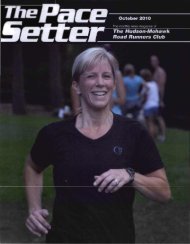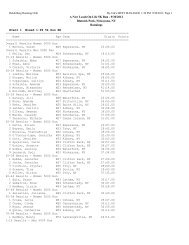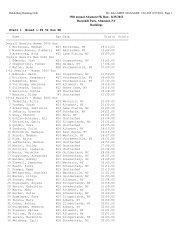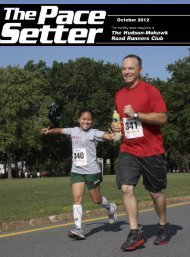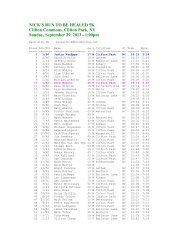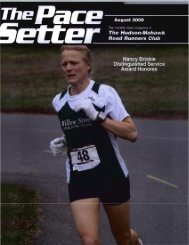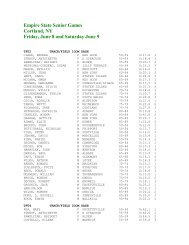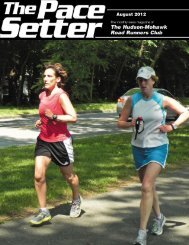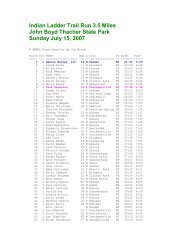October 2011 - Hudson Mohawk Road Runners Club
October 2011 - Hudson Mohawk Road Runners Club
October 2011 - Hudson Mohawk Road Runners Club
You also want an ePaper? Increase the reach of your titles
YUMPU automatically turns print PDFs into web optimized ePapers that Google loves.
The Athlete’s Kitchen<br />
by Nancy Clark, M.S., R.D.<br />
Gluten-Free Sports Diets: Winning Without Wheat<br />
Gluten-free seems to be the latest sports<br />
nutrition buzzword. Gluten is a protein in<br />
wheat, rye and barley that must be avoided by<br />
people (including runners) with celiac disease,<br />
an inherited autoimmune disorder. Symptoms<br />
of celiac vary greatly and can range from digestive<br />
problems (diarrhea, constipation, bloating,<br />
gas) to health problems such as anemia, stress<br />
fractures, infertility in both men and women,<br />
migraine headaches, canker sores, easy bruising<br />
of the skin, swelling of the hands and feet,<br />
and bone/joint pain. The person feels lousy.<br />
Yet, some runners don’t even realize they have<br />
celiac disease. They feel fine—until they experience<br />
iron-deficiency anemia or stress fractures<br />
due to poor absorbtion of iron, calcium,<br />
and vitamin D. Other runners complain about<br />
“runner’s trots” and undesired pit stops.<br />
How common is celiac disease? More than<br />
we once thought! About 1% of the population<br />
(runners included) has celiac and needs<br />
to avoid even traces of gluten. Up to 6% have<br />
non-celiac gluten sensitivity. The symptoms are<br />
similar but without the autoimmune reactions<br />
that result in cancer and osteoporosis. No one<br />
is certain why celia disease and gluten sensitivity<br />
is on the rise. One theory relates to changes<br />
in the composition of our gut bacteria.<br />
How to tell if you are gluten sensitive<br />
If you and others in your genetic family are<br />
plagued with niggling health issues (including<br />
those mentioned above), you should learn<br />
more about celiac disease and gluten sensitivity.<br />
Untreated celiac disease can lead to severe<br />
complications including cancer of the gut and<br />
osteoporosis. Two websites that offer abundant<br />
information include www.celiac.org and<br />
www.glutenfreediet.ca.<br />
If you suspect you are gluten sensitive, don’t<br />
self-impose a gluten-free diet without first talking<br />
with a doctor who specializes in celiac.<br />
You need to get your blood tested for specific<br />
antibodies and then, to confim the diagnosis,<br />
an intestinal biopsy. Do not eliminate gluten<br />
before you get the blood tests, because absence<br />
of gluten in your diet can interfere with<br />
making the correct diagnosis. If you don’t get<br />
properly tested, you might miss a correct diagnosis<br />
or other health problems, like Crohn’s,<br />
an ulcer, or colon cancer. Plus, if undiagnosed,<br />
you might be less motivated to strictly follow a<br />
gluten-free diet for life.<br />
If you are “simply” gluten-sensitive, your<br />
blood tests will report none of the elevated levels<br />
of antibodies that signal celiac disease, but<br />
you will feel unwell. Hence, if you have intestinal<br />
issues, you might want to try a gluten-free<br />
diet for a month or so regardless of the blood<br />
test results. One athlete plagued with muscle<br />
pain stopped eating wheat and her pains disappeared.<br />
She reported she simply “felt better.”<br />
Others report they recover better and<br />
have less stiffness and joint pain with a glutenfree<br />
diet. This might be due to eliminating gluten,<br />
a placebo effect, or eating better overall<br />
(no cookies, pastries, junk food). Adhering to<br />
a gluten free diet is challenging and expensive,<br />
so there’s no need to self-inflict the limitations<br />
if you notice no benefits after a month of gluten-free<br />
eating.<br />
Going gluten free<br />
So what’s a hungry runner to eat if their favorite<br />
pasta, bagels, breads, and baked goods<br />
are off-limits? While a sports diet without pasta<br />
may seem like a day with no sunshine, rest assured,<br />
a plethora of gluten-free carbs can fuel<br />
your muscles. You can enjoy carb-rich rice in<br />
all forms (brown, white, basmati), corn in all<br />
forms (on the cob, cornmeal, grits), potato,<br />
sweet potato, lentils, kidney beans, hummus,<br />
quinoa, millet, and tapioca. Oats, if processed<br />
in a wheat-free plant, can also be safe.<br />
Many fresh foods are naturally gluten-free.<br />
They include all plain fruits, vegetables, milk,<br />
yogurt, hard cheese, eggs, meats, fish, poultry,<br />
nuts, sunflower seeds, edamame, juice, and<br />
wine (but not beer). Just be aware that sauces,<br />
gravies, and seasoning mixes might contain<br />
gluten, as do marinades and soy sauce. Some<br />
gluten-free baked goods, pastas, and frozen<br />
meals are quite good; others might leave you<br />
wishing for something tastier. Two popular<br />
brands of gluten-free bread (commonly available<br />
at Whole Foods or Trader Joe’s) are Udi’s<br />
and Rudi’s. Hint: they taste better when toasted!<br />
Restaurant and Travel Tips<br />
At home, you can easily control your diet.<br />
When on the road, you need to have a plan.<br />
• When traveling, carry “emergency food”<br />
that doesn’t spoil, such as dried fruit, Lara Bars,<br />
and nuts.<br />
• When eating in a restaurant, you’ll have<br />
to quiz the staff and carefully order your food.<br />
Omelets tend to be safe, while salads with<br />
croutons are not. Make sure the steak tips are<br />
not marinated in a gluten-containing sauce, the<br />
turkey was not injected with flavor enhancers,<br />
the gluten-free toast is not made in the same<br />
toaster used for standard breads, the sandwich<br />
is prepared on a paper towel or surface<br />
not used for other breads (to prevent crosscontamination),<br />
the rice in not cooked in broth<br />
with unknown gluten-containing seasonings,<br />
the French fries are not cooked in the same<br />
oil as the breaded chicken, the hamburger is<br />
100% beef (with no fillers) and not cooked on<br />
the same surface as the toasted buns. Some<br />
athletes travel with their own gluten free pasta<br />
and request it be cooked in fresh water, in a<br />
clean pot, and drained into a clean colander.<br />
This all requires a patient waiter and an understanding<br />
chef.<br />
Everyday Gluten-free Sports Food<br />
Suggestions<br />
Even the hungriest Ironman triathletes need<br />
not go hungry on a gluten-free diet! The trick<br />
is to eat fewer processed foods and be a good<br />
label reader. Here are just a few suggestions of<br />
foods you’d find in standard grocery stores.<br />
Breakfast ideas: Fruit smoothie with Greek<br />
yogurt; rice cakes with banana and peanut<br />
butter; scrambled eggs, hash browns, and fruit<br />
salad; Rice or Corn Chex, milk and berries.<br />
Lunch; Tuna salad with baked corn chips;<br />
100% corn tortilla with melted cheese and<br />
pinto beans, Crunchmaster Multigrain crackers<br />
and hummus.<br />
Dinner: baked chicken, potato and beets;<br />
salmon, sweet potato and peas; omelet, corn<br />
and tomatoes; baked potato stuffed with cottage<br />
cheese and salsa; Mexican beans and<br />
rice; shish kabob, rice, salad with oil and vinegar;<br />
frittata (potato, onion and egg “pancake”);<br />
meals with rice, corn, and quinoa.<br />
Snacks: apple and cheese, fruit and yogurt,<br />
baked potato chips, corn chips, Blue Diamond<br />
Nut Thins, rice crackers, trail mix (nuts and<br />
dried fruit), peanut butter and banana, baby<br />
carrots and hummus, popcorn, corn nuts, raisins,<br />
grape juice and all fruit juices, smoothies.<br />
Commercial sports foods: Ensure, Gatorade,<br />
Powerade; Bakery On Main Granola<br />
Bar, Bonk Breaker Bar, Bumble Bar, Clif Nectar<br />
Bar, Clif Builder’s Bar, Enjoy Life Snack Bar,<br />
Elev8Me Bar, Extend Bar, Go Raw Bar, Hammer<br />
Products (Heed, Perpetuem, Bar, Solids),<br />
KIND Bar, Lara Bar, Nonuttin’ Granola Bar,<br />
Odwalla Bar, Omega Smart Bar, PB&Whey<br />
Bar, Perfect 10 Bar, Pure Bar, PureFit Bar, think-<br />
Thin Bar, Quest Bar, Clif Shot Bloks, Gu, Jelly<br />
Belly Sports Beans, Sharkies.<br />
Nancy Clark, MS, RD, CSSD (Board Certified<br />
Specialist in Sports Dietetics) helps both casual<br />
and competitive athletes feel great from the inside<br />
out. Her practice is at Healthworks, the premier<br />
fitness center in Chestnut Hill MA (617-795-1875).<br />
Her Sports Nutrition Guidebook and food guides<br />
for runners, cyclists and soccer players are popular<br />
resources. They are available at www.nancyclarkrd.<br />
com. See also sportsnutritionworkshop.com. r<br />
The Pace Setter – 19



